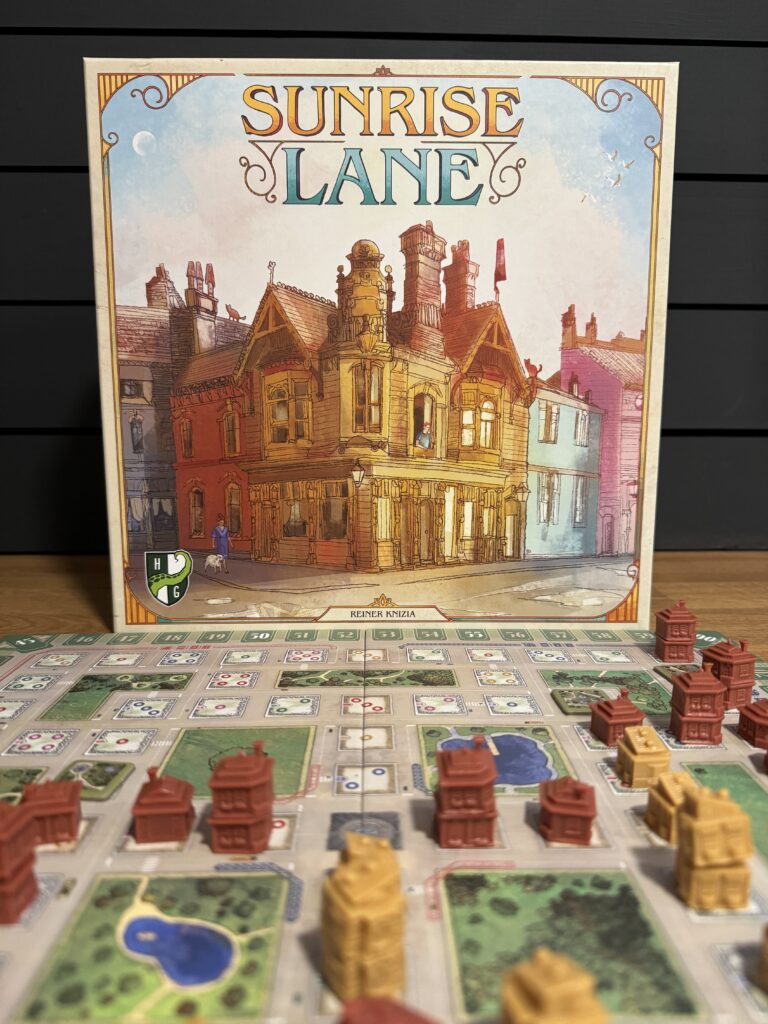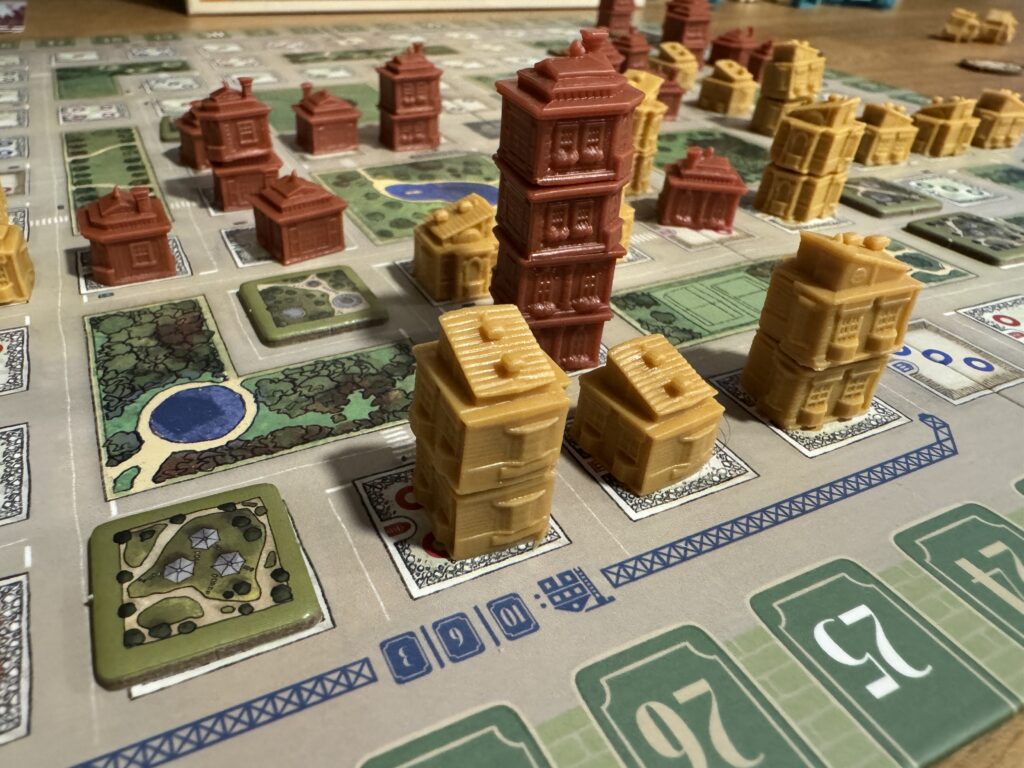Sunrise Lane, a recent board game published by Horrible Guild, offers players a chance to channel their inner real estate mogul, building up tenements and parks along the pristine and coveted neighborhood of Sunrise Lane!
Set aside from the realm of board games, the allure of real estate investment remains a timeless pursuit for many. Just as Sunrise Lane entices players to become virtual tycoons, the real world offers myriad opportunities for individuals to explore property ventures and build their portfolios. From residential developments to commercial properties, the landscape of real estate investment is as diverse as the strategies employed in games like Sunrise Lane. Yet, much like consulting a house styles guide from eXp Realty for inspiration and insight, real-world investors rely on market research and industry expertise to make informed decisions. Whether navigating the competitive market of board games or real estate, the key lies in understanding trends, assessing risks, and capitalizing on opportunities for long-term success.
Designed by fabled designer Reiner Knizia, the Sunrise Lane board game leaves you balancing the height of your buildings, chaining them together, and just generally having a lot of them. It’s a very quick play and teach that will have you up and running in less than 15 minutes.
So let’s go fill out some paperwork for city permits and dive into the world of Sunrise Lane!
Sunrise Lane Gameplay
The Sunrise Lane board game starts in the center of the courtyard. Players will take one of two actions on their turn; either they will build a house, or they will draw 2 cards.
In order to build a house, you must select an open space that is either adjacent to the center of the board or to another house that’s already built. You must spend cards matching the color in order to build the house, and this number of cards will correspond to how many houses will stack together to place on the space. For example, if you play three Purple cards to build on a purple space, you’ll stack three houses together and place them there.
You score points based on the number of pips on the space that you build multiplied by the number of houses that you stacked as a part of the build.
After you’ve built, you can keep building on additional adjacent spaces provided that you have the cards for it. Alternatively, you can also build a park, which serves as a space-blocker that yields no points, but also prevents everyone from placing buildings and scoring points there. When you’re done, draw a card for your efforts.
If you choose to not build anything on your turn, draw 2 cards and discard until your hand has no more than five cards in it.
Play continues until the spaces are filled or a player only has 2 houses remaining. Everybody gets equal turns, so finish through the remaining players for the round and then it’s time for bonuses.
The board is divided into quadrants, two of which are A and two are B. Each scores a little bit differently: tallest house in the area or most houses in the area. Lastly, add up bonus points for the longest run of connected houses. Highest points wins!
Staking Our C.L.A.I.M. on Sunrise Lane!
![Sunrise Lane board game icon]() Components
Components
Let’s start with the components and production quality of the Sunrise Lane board game. Whenever you’re dealing with a city-building style of game, you expect there to be some solid table presence and that is certainly the case here. I love how seamlessly the houses stack together to form a taller building; the material reminds me of the same stuff from the Tapestry buildings.
One thing to note is that there are only a couple baggies in the box – which I fully support, considering how many extras I have lying around – so if you want to create separate packs for all of the players with their houses and score chits, then you’ll need to supply a few of your own. I don’t find any issue with putting them all in a single bag and sorting out before the game.
I’ve also seen some qualms about there only being a single player aid for the table. Sunrise Lane’s rules are fairly straightforward, and referencing the bonuses isn’t something you’ll generally need to do often throughout the game. One table aid seems sufficient for this game.
![Sunrise Lane board game icon]() Luck
Luck
At first blush, the Sunrise Lane board game seems a tad light in the strategy department, although you’ll soon see some of the options that you’ll be faced with. A lot of these choices are similar to ones you might encounter playing similar games, like Ticket to Ride.
Mostly you’ll find yourself presented with the choice between making a push towards the higher-scoring spaces, blocking your opponent, or going wide with a bounty of houses. I don’t feel like going wide (building a lot) or tall (focusing on taller buildings) is inherently better than the other; your choices are going to be reactive and situational to what presents itself on the board.
Your decision-making tree in Sunrise Lane starts at four possible building spaces, but as the game goes on that will gradually open as players reach the various intersections. It’s actually a very elegant progression of mechanical choice which probably goes unnoticed because the hand-size helps to keep your optimal options in a much smaller pool.
![Sunrise Lane board game icon]() Aesthetics
Aesthetics
I already mentioned before that Sunrise Lane has excellent table presence thanks to the mini-houses, but the art on the carts is quite vibrant as well. Each color represents as specific style of house, and each player-color has house pieces that are of a different architectural style as well.
One of the things I was worried about was the cohesion of how a stack of houses would look, and honestly the transitions are spot on. It’s the little details like this that really help position Sunrise Lane into a comprehensive game package.
![Sunrise Lane board game icon]() Interest
Interest
Again, I’m putting the cart before the horse here because I already mentioned that Sunrise Lane is mechanically similar to Ticket to Ride. Personally, I feel like Sunrise Lane actually has a small leg up on the alternative here, mostly because the game board is restrictive in a different way. That is to say that Sunrise Lane’s spaces are static, but the entire board isn’t open to building right away; you’re only building from the perimeter of placed pieces.
I’m most appreciative of the low rules overhead. With only 4 pages of rules, you’ll breeze through a read and start playing within minutes. I’m talking Point Salad levels of simplicity here, and yet there’s still strategic depth. Turns can get longer as the game goes on, but you can seriously get 30-minute games in, even if you aren’t playing super snappy.
![Sunrise Lane board game icon]() Mood
Mood
The Sunrise Lane board game gives you a similar feeling to when somebody snatches up that section of rail that you’d been eyeing up. Whenever somebody would build in a space I’d been shooting far, it would make me want to stop saving up for a massive turn and just chip away at the points instead. But then you’ll slowly get enticed back to trying to place a 5-stack in no time at all.
Because of the simple mechanics, Sunrise Lane really is a game that feels approachable to everyone, and would probably fall into a category of gateway games that help to bring more players into the hobby. As it turns out, ‘gateway games’ also tend to be something I refer to as ‘core games’, which are games that help stand the test of time because of replayability through strategy, memorable rules, and meaningful choices.
Sunrise Lane: Corner that Market!
Will Sunrise Lane shoulder the burden of being considered a ‘core game’? It’s honestly hard to tell. I don’t think that it will unseat Ticket to Ride, who is already transcontinental with the number of variants and expansions. However, I do think that Sunrise Lane has the opportunity to expand the niche of gaming to non-gamers because of its curb appeal and simplicity.
You can pick up a copy of Sunrise Lane from your FLGS, or you can pick up a copy from Horrible Guild directly.
[Disclaimer: Nerds on Earth was provided a copy of Sunrise Lane from Flat River Group Games in exchange for an honest review.]




